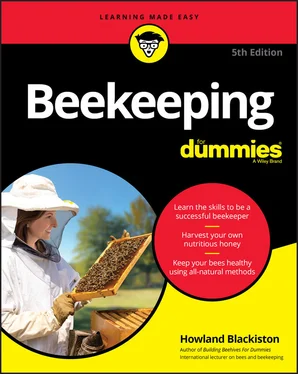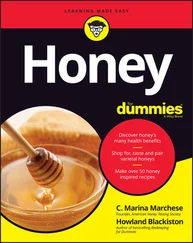1 ...8 9 10 12 13 14 ...20 Proboscis: Everyone’s familiar with those noisemakers that show up at birthday and New Year’s Eve parties. You know, the ones that unroll when you toot them! The bee’s proboscis is much like those party favors, only without the “toot.” When the bee is at rest, this organ is retracted and not visible. But when the bee is feeding or drinking, it unfolds and two basic parts to form a long tube that the bee uses like a straw.
The middle part of the bee is the thorax . It is the segment between the head and the abdomen where the two pairs of wings and six legs are anchored.
Wings: Here’s a trivia question for your next party: How many wings does a honey bee have? The answer is four. Two pairs are attached fore and aft to the bee’s thorax. The wings are hooked together in flight and separate when the bee is at rest.
Legs: The bee’s three pairs of legs are all different. Each leg has multiple segments that make the legs quite flexible. Bees also have taste receptors on the tips of their legs. The bee uses its forward-most legs to clean its antennae. The middle legs help with walking and are used to pack loads of pollen (and sometimes propolis) onto the pollen baskets that are part of the hind legs. Propolis is the sticky, resinous substance that the bees collect from the buds of trees and use to seal up cracks in the hive. Propolis can be harvested and used for a variety of nifty products. (For more information on propolis and what you can do with it, see Chapter 18.) The hind legs (see Figure 2-3) are specialized on the worker bee. They contain special combs and a pollen press, which are used by the worker bee to brush, collect, pack, and carry pollen and propolis back to the hive. Take a moment to closely watch a foraging bee on a flower. You’ll see her hind legs heavily loaded with pollen for the return trip home.
Spiracles: These tiny holes along the sides of a bee’s thorax and abdomen are the means by which a bee breathes. The bee’s trachea (breathing tubes) are attached to these spiracles. Tracheal mites gain access to the trachea through the first hole in the thorax. These mites are a problem for bees; you find out how to deal with tracheal mites in Chapter 13.
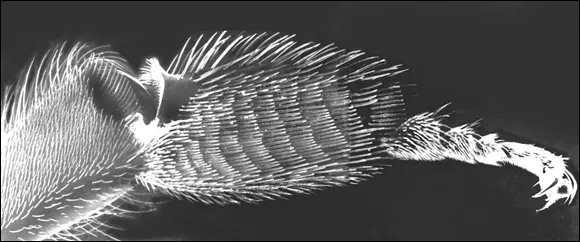
Courtesy of Dr. Eric Erickson, Jr.
FIGURE 2-3:In this close-up image of a worker bee’s leg, you can clearly see the hairs that serve as brushes to collect pollen.
The abdomen is the part of the bee’s body that contains its digestive organs, heart, reproductive organs, wax and scent glands (workers only), and, of course, the infamous stinger (workers and queen only).
The Amazing Language of Bees
It is said that only man and primates have a form of communication superior to that of the honey bee. Like you and I, honey bees use five senses throughout their daily lives; however, honey bees have additional communication aids at their disposal. Two of the methods by which they communicate are of particular interest. One is chemical, the other choreographic.
Pheromones are chemical scents that animals produce to trigger behavioral responses from the other members of the same species. Honey bee pheromones provide the “glue” that holds the colony together. The three types of adults in a hive, of which more is mentioned later in this chapter, produce different pheromones at different times to stimulate specific behaviors. The study of pheromones is a topic worthy of an entire book, so here are just a few basic facts about the ways pheromones help bees communicate:
Certain queen pheromones (known as queen substance, discussed at greater length later in this chapter) let the entire colony know that the queen is in residence and stimulate many worker-bee activities.
Outside of the hive, the queen pheromones act as a sex attractant to potential suitors (male drone bees from other colonies). They also help regulate the drone (male bee) population in the hive.
Queen pheromones stimulate many worker-bee activities, such as comb-building, brood-rearing, foraging, and food storage.
The worker bees at the hive’s entrance produce pheromones that help guide foraging bees back to their hive. The Nasonov gland (discussed later in this chapter) at the tip of the worker bee’s abdomen is responsible for this alluring scent.
Worker bees produce alarm pheromones that can trigger sudden and decisive aggression from the colony.
The colony’s brood (developing bee larvae and pupae) secretes special pheromones that help worker bees recognize the brood’s gender, stage of development, and feeding needs.
Perhaps the most famous and fascinating “language” of the honey bee is communicated through a series of dances done by foraging worker bees who return to the hive with news of nectar, pollen, or water. The worker bees dance on the comb using precise patterns. Depending on the style of dance, a variety of information is shared with the honey bees’ sisters. They’re able to obtain remarkably accurate information about the location and type of food the foraging bees have discovered.
Two common types of dances are the round dance and the waggle dance.
The round dance communicates that the food source is near the hive (within 10–80 yards). Figure 2-4 illustrates dancing movements.
For a food source found at a greater distance from the hive, the worker bee performs the waggle dance. It involves a shivering side-to-side motion of the abdomen while the dancing bee moves in a figure eight pattern. The vigor of the waggle, the number of times it is repeated, the direction of the dance, and the sound the bee makes communicate amazingly precise information about the location of the food source. See Figure 2-4.
The dancing bees pause between performances to offer potential recruits a taste of the goodies they bring back to the hive. Combined with the dancing, the samples provide additional information about where the food can be found and what type of flower it is from.
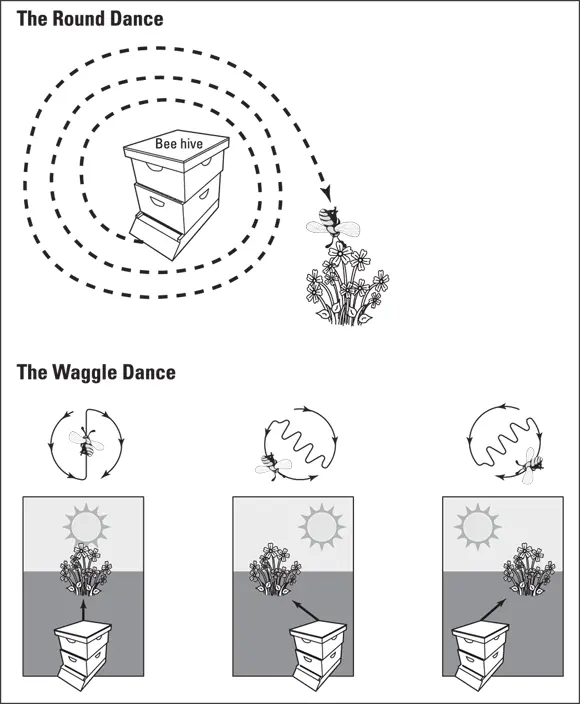
Courtesy of Howland Blackiston
FIGURE 2-4:The round dance (top) and the waggle dance (bottom).
Getting to Know the Male and the Two Female Castes
During summer months, about 60,000 or more bees reside in a healthy hive. And while you may think that all those insects look exactly alike, the population actually includes two different female castes (the queen and the workers) and the male bees (drones; see Figure 2-5). Each type has its own characteristics, roles, and responsibilities. Upon closer examination, the three look a little different. Being able to distinguish one from the other is important.
Let there be no mistake about it — the queen bee is the heart and soul of the colony. There is only one queen bee in a colony. She is the reason for nearly everything the rest of the colony does. The queen is the only bee without which the rest of the colony cannot survive. Without her, your hive is sunk. A good-quality queen means a strong and productive hive. For more information on how to evaluate a good queen, see Chapter 8. And for some real fun, try raising your own queens from your best performing hives. See Chapter 14.
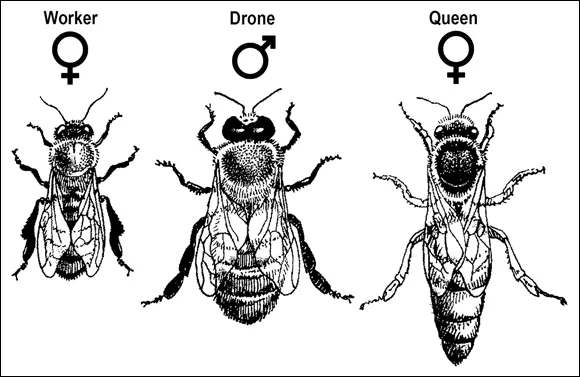
Courtesy of Howland Blackiston
Читать дальше
